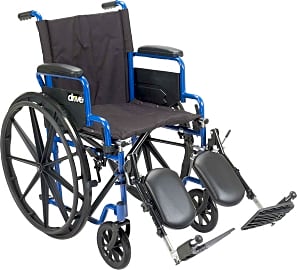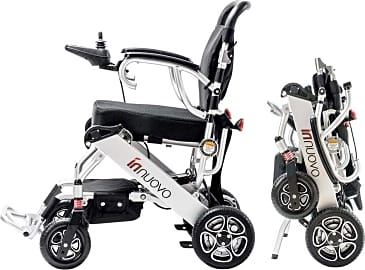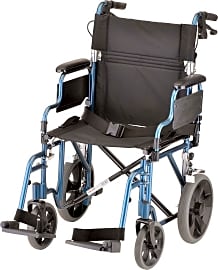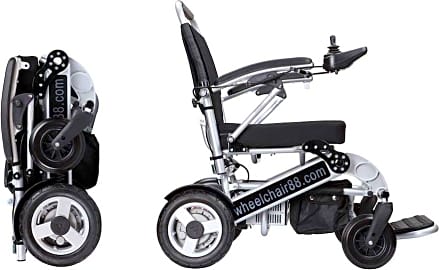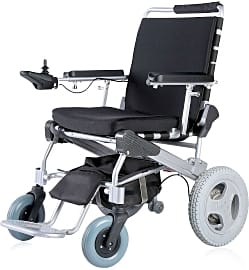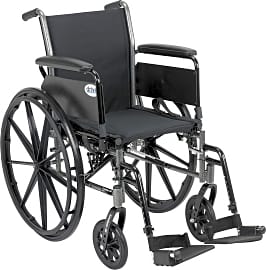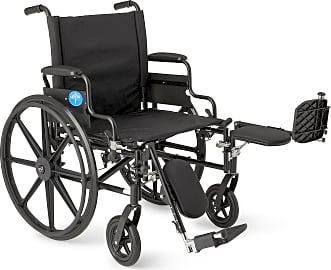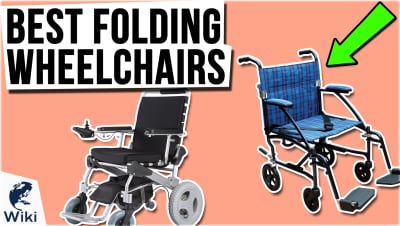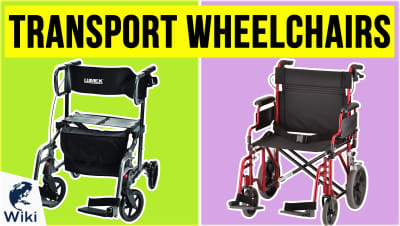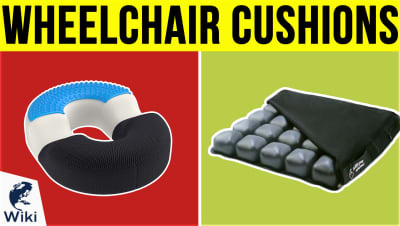The 10 Best Wheelchairs

This wiki has been updated 40 times since it was first published in February of 2015. Whether you're in the market for a workhorse to power your way through everyday activities or a stopgap solution for a loved one who's temporarily off his or her feet, the range of available wheelchair options is as diverse as the people who rely on them to get around. Our selection includes everything from lightweight, manual choices to heavy-duty electric models for conquering tricky terrains. When users buy our independently chosen editorial picks, we may earn commissions to help fund the Wiki.
Editor's Notes
December 26, 2019:
New to our selection today are three reliable models, including the Drive Medical Blue Streak, a lightweight, ergonomic choice that’s convenient for both transport and transfer purposes. Currently offered at less than $120, it’s a good value for the price, with an easy-to-assemble design and a protective, powder-coated frame that's well suited for use outdoors. It’s available in 16-, 18-, and 20-inch sizes, with either swing-away footrests or elevating leg rests.
For another affordable choice, look to the manual Medline Lightweight, which is conducive for office work, and also makes it easy to navigate right up to the table for family dinners, thanks to its flip-back, desk-length arms. It can support users of up to 300 pounds and features soft, breathable nylon upholstery that makes it comfortable to sit in for extended periods.
The Innuovo Intelligent is a battery-powered model, and one of the more lightweight ones, as it weighs in at just 50 pounds. This makes it relatively easy to transport in the back of your vehicle. In fact, it folds up in as little as three seconds. It’s also easy to operate via the 360-degree joystick and anti-lean design. It’s equipped with a thick, comfortable seat cushion and an efficient electromagnetic braking system.
Leaving the list to make room for more suitable, diverse models are the Karman S-Ergo 305 and the Wallaby Pediatric. Also making its departure, due to lack of availability, is the Hippocampe All-Terrain. Those interested in additional models that are compact and lightweight can check out our lists of best folding wheelchairs and best transport wheelchairs.
For safety’s sake, always make use of a wheelchair’s seatbelt when it’s in use, and be sure to engage the brakes before you or a patient transfers in or out of it. To avoid injury, never let a child play on a wheelchair.
Special Honors
Invacare Storm Series 3G Torque SP This model’s high torque makes it well suited for many rehab needs. Its rear-wheel suspension helps absorb significant jolts and impacts, to ensure a smooth ride. This highly customizable choice offers optional TrueTrack technology to keep it on a truer forward path to lessen fatigue, and you can also choose gearless, brushless motors to help improve the battery range. invacare.com
Redman Standing Power Chair This versatile model allows you to stand, recline, tilt, and stretch, providing more body positioning options than most others. Its adjustable arm rests ensure comfort and support at all times. Made in America, it offers custom sizing with a maximum weight limit of 350 pounds, a three-inch ground clearance, and a seat depth of 18 inches. Many features can be added on to meet your needs and preferences. It can reach a speed of up to nine miles per hour and can drive for up to 20 miles per charge. redmanpowerchair.com
Adaptive Star Axiom Endeavor This highly durable choice is great for those who enjoy the outdoors, and it’s well suited for anything from neighborhood walks to five-mile runs to beaches to theme parks. It’s available in three sizes and in either red or navy, with more than 10 add-ons that include a head rest, hip abductor, positioning wedges, harness extension, rain canopy, seat padding, and a flashing light. With two adjustable footwells that can accommodate passenger growth, it can support users of up to 200 pounds. adaptivestar.com
What Do I Need to Consider Before Buying a Wheelchair?
But installing a motorized platform is expensive, and any van will need to be converted before it can house a motorized platform inside.
The first thing that any person needs to consider before purchasing a wheelchair is how that wheelchair is going to be used. If the wheelchair is going to be used by a public facility - like, say, a nursing home - then it needs to feature an adjustable seat (preferably cushioned), adjustable braces, and a weight capacity of at least 250 lbs. for accommodating a wide range of residents.
If, on the other hand, you're looking for a wheelchair that can accommodate one person, the primary areas that you'll want to consider are that person's upper-body strength, mobility, measurements, and limitations. Any person whose physical abilities are limited, for example, might benefit from using a wheelchair with electronic steering, whereas a person who is active might actually prefer the opportunity to operate a wheelchair on his own.
Bear in mind that any wheelchair you plan on transporting in a vehicle needs to be collapsible and lightweight. Certain vans can be customized to accommodate a wheelchair and its user by way of a detachable ramp or a motorized platform. But installing a motorized platform is expensive, and any van will need to be converted before it can house a motorized platform inside.
As a precaution, you'll want to take a look at any wheelchair's tires. Most wheelchair tires are made out of rubber or plastic, which is ideal for rolling over indoor surfaces, as well as asphalt and concrete. Certain tires might also feature herringbone tread, which is beneficial in terms of moving over slick terrain without feeling like the wheels might slide, stall, or spin.
Several Tips For First-Time Wheelchair Users
The first challenge that a lot of wheelchair users face is learning how to turn the wheelchair around. Turnarounds can be accomplished rather easily by pushing one of the chair's wheels forward, while turning the other wheel back. After a bit of practice, this maneuver should become routine.
If you use your wheelchair inside a house or an office, it may be worth tying a three-foot length of rope to any doorknobs that you pass.
If you use your wheelchair inside a house or an office, it may be worth tying a three-foot length of rope to any doorknobs that you pass. This way you can grab that length of rope, and then use it to pull the doorknob shut. If you work at a desk, be sure to draw back your wheelchair's armrests so that you can position your seat beneath the desk, parallel with its drawers.
Negotiating an incline while in a wheelchair can be challenging. Rather than risk going backward, you may want to lock the brake and catch your breath before moving on. Either that or you can look into buying a pair of grade aids (i.e., wheelchair accessories that make it easier to steer and lock while on a gradient). If you operate a wheelchair near any busy intersections, wearing bright colors - or a safety vest - can alert oncoming traffic to use caution.
Strong tires are the lifeblood of any wheelchair, which is why it makes sense to check the air in your tires on a consistent basis. Deflated tires exhaust your arms by making it more difficult to push. On top of that, empty tires tend to grind beneath a wheelchair's rims. This causes wear, which could, in turn, lead to the need for a replacement. Once a year, it helps to have a wheelchair's bearings checked by a professional, as well.
A Brief History of The Wheelchair
During the 2nd century B.C.E., the Ancient Chinese began using wheelbarrows as a means of transporting the sick, disabled, mortally injured, and the dead. This represented the earliest record of any wheeled vehicles being used for health-related transport. Approximately 1,000 years later, the Chinese invented the world's first wheelchair, a mechanism designed specifically for use by people who had missing or paralyzed legs.
Everest was paralyzed, having broken his back during a mountain-climbing accident.
Wheelchairs remained fairly basic until the 1800s, at which point an inventor from Bath, England patented what would become known as the Bath Chair. Bath chairs looked and functioned like miniature coaches. They were designed with three wheels, a cushioned seat, a canopy, and a hitch so they could be attached to bicycles, donkeys, and sometimes even dogs.
The first collapsible wheelchairs were invented by a pair of American engineers named Harry Jennings and Herbert Everest in 1933. Everest was paralyzed, having broken his back during a mountain-climbing accident. And it was because of this that Everest was able to suggest several structural improvements, including a collapsible frame (for ease of transport), cushioned armrests, and a steel-plated design. Earlier wheelchairs were primarily constructed out of wood, which was not only breakable, but uncomfortable, meaning that users could only remain in the chair for an abbreviated period of time.
Despite being introduced during the 1960s, electric-powered wheelchairs didn't really come into their own until the Reagan Era, at which point advances in technology allowed for adding a handheld joystick (for steering), and numerous other forms of remote control.
Perhaps the most fascinating wheelchair innovations over the past 30 years have occurred in the area of athletics, with streamlined models making it increasingly possible for disabled athletes to excel at basketball, competitive racing, and even handcycling (among other things). There are certain hybrid wheelchairs on the market that have grown so advanced, they can actually enable a paralyzed person to stand and move upright whenever operating them. One of these models, which is known as the iBot, currently retails for a little over $25,000.


